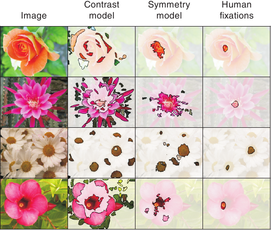Symmetry to Predict Human Attention

Fig 1. The columns respectively show:
a) the image, b) response of the contrast
model, c) response of the symmetry model,
and d) the human response.
A popular visual-attention model is the saliency model of Itti, Koch, and Niebur (1998). Their model makes predictions based on contrasts in the image. Although this contrast-saliency model is shown to be successful, we can see in the second column of fig. 1 that it does not correctly predict the human eye fixations. Instead of focussing on the center, the model highlights the borders of the flowers where the contrast with the background is high. To deal with this deficiency in current models, we propose a visual-attention model based on symmetry.
Symmetry as a salient feature
Symmetry is a visual feature that is highly abundant in our daily environments. It is known from earlier psychophysical studies that humans are very sensitive to symmetry in visual patterns. Symmetry is detected and recognized very rapidly. We moreover showed that search for symmetrical patterns is efficient, suggesting that it is perceived preattentively.The predictions of our symmetry-saliency model are shown in the third column of fig. 1. The predictions correlate very well with the human eye fixations. Moreover, we showed that the predictions of the symmetry-saliency model are better than that of the contrast-saliency model for a wide variety of images, from street scenes to natural scenes.
To get more information on the results, go to the result page.
Saliency Inspector
To view some of the images with their fixation distance maps and the response of the different saliency models, use the saliency inspector.Data
The eye-tracking data is freely available for scientific, non-commercial uses. If you publish work based on this data, please refer to our papers.Publications
- Kootstra, G., de Boer, B., and Schomaker L.R.B. (2011)
Predicting Eye Fixations on Complex Visual Stimuli using Local Symmetry.
Cognitive Computation, 3(1):223-240.
doi: 10.1007/s12559-010-9089-5
link
- Kootstra, G. & Schomaker, L.R.B. (2009) Prediction of Human Eye Fixations using Symmetry. In N. A. Taatgen & H. van Rijn (Eds.), Proceedings of the 31st Annual Conference of the Cognitive Science Society (CogSci09), July 29 - Aug 1, 2009, Amsterdam, The Netherlands. pdf
- Kootstra, G., Nederveen, A. & De Boer, B. (2008) Paying Attention to Symmetry. In: Proceedings of the Belgium-Netherlands Artificial Intelligence Conference. October 30-31 2008. Enschede, The Netherlands.
- Kootstra, G., Nederveen, A. & de Boer, B. (2008) Paying Attention to Symmetry. In: Proceedings of the British Machine Vision Conference (BMVC2008) pp. 1115-1125, September 1-4, 2008, Leeds, UK. pdf
- Kootstra, G., Nederveen, A. & de Boer, B. (2006) On the Bottom-Up and Top-Down Influences of Eye Movements. In: Proceedings of CogSci 2006 Conference, p. 2538, July 26-29, 2006, Vancouver, Canada. (abstract not available, poster pdf)